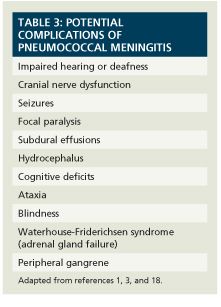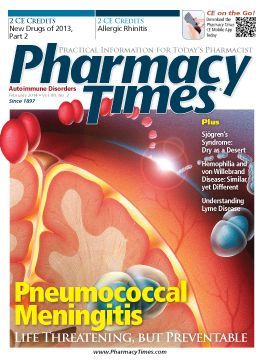Publication
Article
Pharmacy Times
Pneumococcal Meningitis: Life Threatening, but Preventable
Author(s):
Promoting vaccination against Streptococcus pneumoniae can prevent meningitis and related complications.
Promoting vaccination against Streptococcus pneumoniae can prevent meningitis and related complications.
Every autumn and winter, health care professionals around the world see Streptococcus pneumoniae infections peak (although they occur year-round). Here in the United States, S pneumoniae, a gram-positive coccus, is the most common preventable cause of community-acquired pneumonia, bacteremia, otitis media, and bacterial meningitis. This gram-positive bacterium has more than 90 known serotypes and 46 serogroups, which are determined by the specific bacterium’s capsule polysaccharide composition.1-4
This article examines S pneumoniae (also called pneumococcal) meningitis, a clinical syndrome characterized by inflammation of the triple-layered connective tissue cover (the meninges) of the central nervous system (CNS). Meningitis tends to present in a classic pattern, but other symptoms are possible (Table 1). Risk of infection—and mortality— is highest in the first year of life, decreases in midlife, and increases again in old age.5-7 Roughly 19% to 26% of patients who acquire pneumococcal meningitis die, and approximately 15% of survivors have residual and severe handicaps, such as deafness or brain injury.3,8,9
In addition to being the most common cause of meningitis, S pneumoniae is the most common cause of meningitis associated with basilar skull fracture and cerebrospinal fluid (CSF) leak; affected patients often have rhinorrhea or otorrhea. 10 In its worst form, the infection disseminates to cause concurrent multi-organ infections (eg, in the lungs, sinuses, or heart). Rarely, patients acquire Austrian syndrome, which is concurrent pneumococcal meningitis, endocarditis, and pneumonia; the likelihood of Austrian syndrome is highest in patients who are immunocompromised, have had transplants, or are alcoholic.11,12
The Logistics of Invasion
S pneumoniae asymptomatically colonizes the human nasopharynx (the nose and throat); up to 10% of healthy adults are colonized, and up to 40% of healthy children are.13 Approximately 25% of patients who develop pneumococcal meningitis have clinically significant sinusitis or otitis.8 In susceptible individuals, the bacteria circumvent local host defenses and phagocytosis, invading nearby spaces (the sinuses or ears) or causing bacteremia. The organism penetrates the CNS via the bloodstream to cause meningitis.3,14
Patients at increased risk for S pneumoniae infection include those with alcoholism, diabetes, hyposplenism, hypogammaglobulinemia, malnutrition, multiple myeloma, or renal or hepatic insufficiency. People with cochlear implants or who are receiving glucocorticoid treatment are also at increased risk of infection.3,14
Meningitis is a medical emergency, and the only suitable action is hospitalization.
Treatment: Move Quickly
As soon as clinicians suspect a case of pneumococcal meningitis, they should initiate empiric parenteral antibacterial therapy. Oral antibiotics are contraindicated; the entire regimen must be delivered parenterally. Penicillin resistance among S pneumoniae strains is increasing globally, so culture and sensitivity testing are essential.15,16
Once the diagnosis is confirmed and the strain’s susceptibility clarified, age- and condition-appropriate targeted antibiotic therapy is critical for at least 10 days. In addition, steroids (usually dexamethasone) are often used in children 6 weeks and older.1 Many clinicians employ steroids only with caution and careful monitoring in adult patients with bacterial meningitis, because steroids may decrease CSF antibiotic concentrations. 17,18 Online Table 2 lists currently recommended treatments.
Table 2: Current Treatment Recommendations for Pneumococcal Meningitis
Presumed bacterial meningitis (culture and sensitivity testing pending)
Vancomycin plus a beta-lactam (ceftriaxone, cefotaxime, or a penicillin)
Use doses suggested for central nervous system penetration
Confirmed bacterial meningitis (culture and sensitivity testing complete)
Vancomycin plus a beta-lactam (ceftriaxone, cefotaxime, or a penicillin)
Whether the isolate is penicillin- or cephalosporin-resistant in vitro, continue this regimen for at least 10 days:
- Add rifampin if the pneumococcal isolate is sensitive and (1) the patient’s clinical condition worsens over 48 hours, (2) repeat lumbar puncture shows persistently positive culture results, and/or (3) the isolate displays a minimum inhibitory concentration to cefotaxime/ceftriaxone of 4 mcg/mL or greater
- Meropenem, chloramphenicol, or a fluoroquinolone is a possible alternative
In the acute phase, patients may experience hypotension or shock, hypoxemia, hyponatremia, cardiac arrhythmias and ischemia, stroke, or exacerbation of chronic diseases. Treating clinicians need to identify and treat each of these rapidly as they occur. Intravenous fluids, parenteral/ enteral nutrition, and other indicated medications are necessities when the above effects occur.15
Complications
Research indicates that up to 15% of pneumococcal meningitis survivors suffer significant neurologic complications even if antimicrobial therapy cures the underlying meningitis. Patients who present with severe neurologic impairment or rapid-onset illness have a risk of death that is between 50% and 90%, even with treatment.9 Close monitoring for complications is crucial. Table 3 lists possible complications.

Seizures are a significant complication because they develop in approximately 30% of patients. Children younger than 1 year are at highest risk, with about 40% affected. Half of patients who develop seizures have more than 1 seizure. The risk for resultant diffuse CNS ischemic injury or systemic complications is high. For this reason, clinicians order seizure precautions and airway protection.19,20
Hearing loss is also a serious concern. Risk factors for hearing loss after pneumococcal meningitis are female gender, older age, severe meningitis, and infection with certain pneumococcal serotypes (eg, 3, 12F, 23F).21
Final Note
Clearly, pneumococcal meningitis is a life-threatening medical emergency. The most important information pharmacists can convey to patients is that neglecting preventive vaccination is a foolish decision. In the United States, widespread uptake of 7-valent pneumococcal conjugate vaccine (PCV7) immunization after the year 2000 dramatically decreased pneumococcal disease. Within a year, invasive pneumococcal disease caused by serotypes contained in the vaccine was completely eliminated in children younger than 5 years. Overall, the vaccine reduced preventable infection by 94% in individuals of all ages.19 Infants are now routinely immunized against the 13 most common strains of S pneumoniae. Vaccines are also available for adults. Promoting these vaccinations can prevent infection and its most serious complications.
Virginia Bartok is a retired pharmacist who comes out of retirement to write. Her primary practice was in indigent care, and she currently provides case management for several geriatric patients.
References
- Committee on Infectious Diseases; American Academy of Pediatrics. Pneumococcal infections. In: Pickering LK, Baker CJ, Long SS, McMillan JA, eds. Red Book 2009 Report of the Committee on Infectious Diseases. 28th ed. American Academy of Pediatrics; 2009:525-335.
- Ludwig E, Bonanni P, Rohde G, Sayiner A, Torres A. The remaining challenges of pneumococcal disease in adults. Eur Respir Rev. 2012;21:57-65.
- Centers for Disease Control and Prevention. Pneumococcal disease. www.cdc.gov/pneumococcal/clinicians/clinical-features.html. Accessed January 2, 2014.
- Thigpen MC, Whitney CG, Messonnier NE, et al. Bacterial meningitis in the United States, 1998-2007. N Engl J Med. 2011;364:2016-2025.
- World Health Organization. Weekly epidemiological record. March 2007. www.who.int/topics/meningitis/en/. Accessed January 2, 2014.
- World Health Organization. Pneumococcal vaccines WHO position paper—2012. www.who.int/wer/2012/wer8714.pdf?ua=1. Accessed February 18, 2014.
- Rudan I, Campbell H. The deadly toll of S pneumoniae and H influenzae type b. Lancet. 2009;374:854-856.
- van de Beek D, de Gans J, Spanjaard L, Weisfelt M, Reitsma JB, Vermeulen M. Clinical features and prognostic factors in adults with bacterial meningitis. N Engl J Med. 2004;351:1849-1859.
- Siddiqui EU. Neurologic complications of bacterial meningitis. http://cdn.intechopen.com/pdfs/34319/InTech-Neurologic_complications_of_bacterial_meningitis.pdf. Accessed January 2, 2014.
- McCutcheon BA, Orosco RK, Chang DC, et al. Outcomes of isolated basilar skull fracture: readmission, meningitis, and cerebrospinal fluid leak. Otolaryngol Head Neck Surg. 2013;149:931-939.
- Belvisi V, Del Borgo C, Morelli F, et al. Late onset invasive pneumococcal disease in a liver transplanted patient: beyond the Austrian syndrome. Transpl Infect Dis. 2013;15:E111-E114.
- Kanakadandi V, Annapureddy N, Agarwal SK, et al. The Austrian syndrome: a case report and review of the literature. Infection. 2013;41:695-700.
- Hussain M, Melegaro A, Pebody RG, et al. A longitudinal household study of Streptococcus pneumoniae nasopharyngeal carriage in a UK setting. Epidemiol Infect. 2005;133:891-898.
- FDA public health notification: importance of vaccination in cochlear implant recipients. FDA website. www.fda.gov/MedicalDevices/Safety/AlertsandNotices/PublicHealthNotifications/ucm062057.htm. Accessed January 2, 2014.
- Muench DF, Cunha BA. Pneumococcal infections. http://emedicine.medscape.com/article/225811-overview#aw2aab6b2b5aa. Accessed January 2, 2014.
- Hameed N, Tunkel AR. Treatment of drug-resistant pneumococcal meningitis. Curr Infect Dis Rep. 2010;12:274-281.
- van de Beek D, de Gans J, McIntyre P, Prasad K. Steroids in adults with acute bacterial meningitis: a systematic review. Lancet Infect Dis. 2004;4:139-143.
- van de Beek D, de Gans J, Tunkel AR, et al. Community-acquired bacterial meningitis in adults. N Engl J Med. 2006;354:44-53.
- O’Brien KL, Wolfson LJ, Watt JP, et al. Burden of disease caused by Streptococcus pneumoniae in children younger than 5 years: global estimates. Lancet. 2009;374:893-902.
- Zoons E, Weisfelt M, de Gans J, et al. Seizures in adults with bacterial meningitis. Neurology. 2008;70(22, pt 2):2109-2115.
- Heckenberg SG, Brouwer MC, van der Ende A, Hensen EF, van de Beek D. Hearing loss in adults surviving pneumococcal meningitis is associated with otitis and pneumococcal serotype. Clin Microbiol Infect. 2012;18:849-855.

Newsletter
Stay informed on drug updates, treatment guidelines, and pharmacy practice trends—subscribe to Pharmacy Times for weekly clinical insights.






